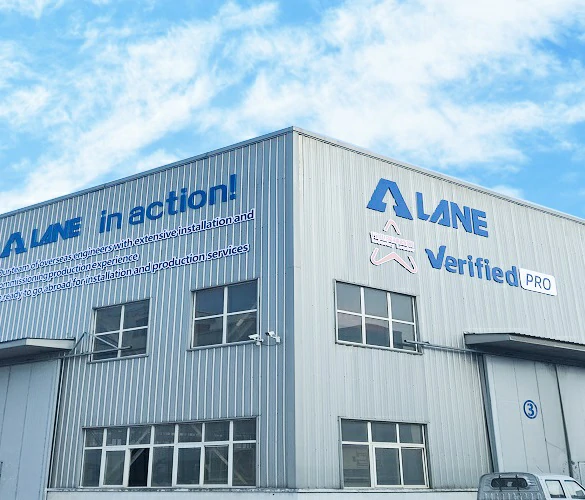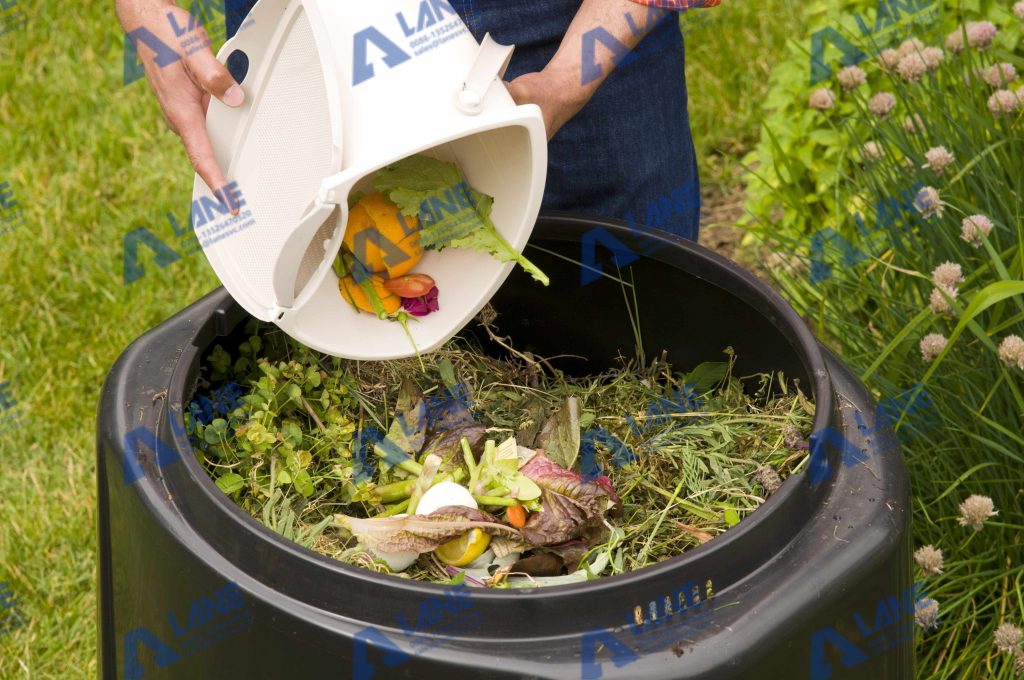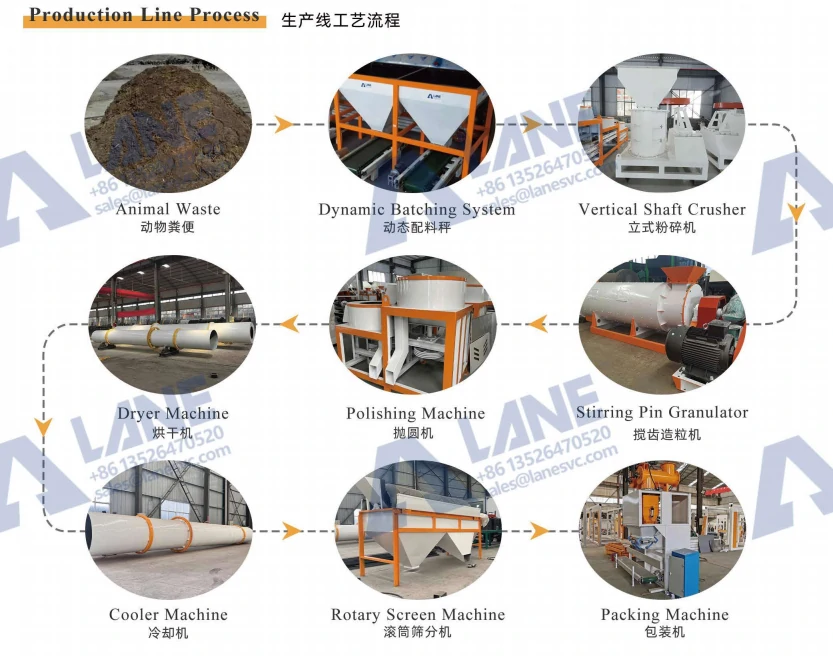Why the World Needs Organic Fertilizer Plants Using Food Waste
Organic fertilizer plant using food waste is becoming one of the most effective and eco-friendly solutions to global waste and soil degradation problems. Every year, millions of tons of food waste are discarded worldwide—rotting in landfills, emitting methane, and polluting groundwater. Yet this same waste contains essential nutrients like nitrogen, phosphorus, and potassium that plants need to thrive.
Transforming this waste into valuable organic fertilizer is not just an environmental act—it’s an economically sound investment. In regions with high agricultural activity such as Southeast Asia, Africa, and Latin America, establishing an organic fertilizer plant using food waste is proving to be a sustainable path to soil health, reduced chemical dependency, and circular economy growth.
LANE Heavy Industry, with years of experience in composting and fertilizer equipment manufacturing, has been supporting this transition by providing complete solutions—from compost turners and crushing machines to fermentation systems and granulating lines.

Understanding the Potential of Food Waste as Fertilizer Raw Material
Food waste is a nutrient-rich organic resource. It typically contains:
| Component | Average Content (%) | Role in Fertilizer |
| Organic matter | 60–70 | Improves soil structure and aeration |
| Nitrogen (N) | 1.5–2.5 | Promotes leaf and stem growth |
| Phosphorus (P₂O₅) | 0.5–1.0 | Encourages root and flower development |
| Potassium (K₂O) | 0.8–1.2 | Enhances plant disease resistance |
| Moisture | 40–60 | Facilitates microbial activity |
When processed properly in an organic fertilizer plant using food waste, these elements are stabilized and converted into nutrient-balanced, odor-free fertilizer suitable for agriculture, horticulture, and landscaping.

The Core Process of an Organic Fertilizer Plant Using Food Waste
An organic fertilizer plant using food waste follows a systematic process to ensure quality, safety, and efficiency. Below is a detailed breakdown of the production stages and corresponding equipment, commonly supplied by LANE Heavy Industry.
1. Raw Material Collection and Sorting
Food waste is collected from restaurants, markets, and households. The waste must be sorted to remove plastics, metals, and glass. Sorting can be semi-automatic using a conveyor and magnetic separator.
LANE’s stainless steel belt conveyors are corrosion-resistant and ideal for transporting high-moisture organic matter safely.
2. Crushing and Mixing
Larger waste chunks (like fruits, vegetables, or bones) are crushed into smaller pieces to improve microbial fermentation. A food waste crusher or semi-wet material grinder is commonly used.
The crushed material is then blended with other organic inputs such as sawdust, rice husks, or animal manure to balance the carbon-to-nitrogen (C/N) ratio around 25–30:1, optimal for composting.
3. Composting and Fermentation
This is the heart of an organic fertilizer plant using food waste. The mixture undergoes aerobic fermentation for 15–20 days, during which temperature, moisture, and oxygen are carefully regulated.
LANE provides several composting systems:
Crawler type compost turner – ideal for large-scale outdoor composting.
Wheel type compost turner – suitable for indoor fermentation with longer windrows.
Groove type compost turner – for controlled composting in fermentation trenches.
These machines efficiently turn and aerate the piles, accelerating microbial activity and ensuring uniform decomposition. Temperature can reach 60–70°C, effectively killing pathogens and weed seeds.
4. Crushing, Screening, and Aging
After fermentation, the composted material is left to mature for a few days. It is then crushed again to achieve fine granularity and screened to remove oversized particles. This ensures a consistent and marketable product.
5. Granulation and Drying
Granulating the composted material improves appearance, storage, and application efficiency. The following equipment is typically used in a modern organic fertilizer plant using food waste:
Disc granulator or rotary drum granulator for forming uniform pellets.
Rotary dryer and cooler to stabilize moisture below 10%.
Screening machine to separate qualified granules.
Automatic packaging system for weighing and sealing bags.
LANE’s granulating lines are modular, customizable, and energy-efficient—suitable for both 1–2 t/h small plants and 10–20 t/h industrial-scale operations.

Economic Benefits of Organic Fertilizer Plants Using Food Waste
Investing in an organic fertilizer plant using food waste yields both environmental and financial returns. Below is an overview:
| Benefit | Description |
| Waste reduction | Reduces landfill pressure and methane emissions |
| Cost savings | Converts waste disposal costs into valuable fertilizer products |
| Job creation | Provides employment in collection, processing, and marketing |
| Agricultural profit | Increases soil fertility and crop yield |
| Carbon footprint reduction | Helps meet sustainability targets for governments and companies |
A medium-sized plant processing 50 tons of food waste per day can produce approximately 25–30 tons of organic fertilizer daily. Depending on market price ($100–$200 per ton), annual revenues can exceed $1.5–2 million.
Case Study: A Successful Organic Fertilizer Project in Indonesia
In 2024, LANE Heavy Industry cooperated with a municipal government in Central Java, Indonesia, to build an organic fertilizer plant using food waste. The project aimed to manage large amounts of market and restaurant waste—over 100 tons per day—that previously went to landfills and caused odor and methane emissions.
LANE provided a full set of equipment, including a crawler type compost turner, semi-wet crusher, rotary drum granulator, and automatic packing system. The plant now processes about 50 tons of food waste daily, producing nearly 25 tons of organic fertilizer that meets Indonesia’s agricultural standards.
After half a year of operation, the results were impressive:
Waste sent to landfill reduced by 30%
Local farms reported higher soil fertility and 10–15% better yields
Over 40 new jobs created in collection and plant operation
The organic fertilizer brand “EcoGrow”, produced from food and vegetable waste, is now used widely in vegetable farms and coffee plantations. Encouraged by its success, the government plans to expand similar waste-to-fertilizer facilities in other Indonesian cities with LANE’s technical support.
How LANE Supports Your Organic Fertilizer Project
LANE Heavy Industry offers a comprehensive service for anyone looking to establish an organic fertilizer plant using food waste, including:
Customized design based on available materials, space, and budget
Complete production line supply from composting to granulation
Installation guidance and on-site technical training
After-sales support and spare parts supply
Flexible capacity options from pilot-scale to large industrial plants
Our equipment is built from high-grade carbon steel or stainless steel 304, with advanced anti-corrosion coatings, ensuring long service life and low maintenance. Many of our clients operate plants for over a decade with minimal downtime.
Environmental and Social Impact
Developing an organic fertilizer plant using food waste contributes to multiple Sustainable Development Goals (SDGs):
SDG 2 (Zero Hunger): Improves soil fertility, increases crop productivity
SDG 12 (Responsible Consumption and Production): Reduces food waste
SDG 13 (Climate Action): Lowers greenhouse gas emissions
SDG 8 (Decent Work and Economic Growth): Creates green jobs
In addition, local farmers benefit from access to affordable, organic fertilizers that enhance soil biodiversity and water retention.
Challenges and Solutions in Operating a Food Waste-Based Fertilizer Plant
Operating an organic fertilizer plant using food waste is not without challenges. Common issues include:
| Challenge | LANE’s Solution |
| High moisture content | Use dewatering machine and compost turner to maintain 55–60% |
| Odor control | Aerobic fermentation with regular turning to avoid anaerobic smell |
| Contaminants in raw material | Pre-sorting and magnetic separation systems |
| Quality consistency | Add microbial inoculants and maintain C/N balance |
| Market competition | Develop branded organic fertilizer with local marketing strategy |
LANE engineers provide customized process optimization to address these problems effectively.
Future Outlook: The Next Generation of Organic Fertilizer Plant Using Food Waste
The future of organic fertilizer plants using food waste lies in automation and digital monitoring. LANE is currently developing IoT-enabled composting systems that track temperature, moisture, and oxygen levels in real time, allowing operators to control the fermentation process via mobile apps.
Moreover, combining anaerobic digestion with composting can produce both biogas and organic fertilizer, achieving maximum resource recovery.
Frequently Asked Questions (FAQ)
Q1: What types of food waste are suitable for fertilizer production?
Most biodegradable food waste such as fruit peels, vegetable scraps, rice, bread, and meat residues can be used. Avoid plastic, glass, and large bones.
Q2: How long does it take to produce organic fertilizer from food waste?
Typically 20–30 days, depending on temperature, humidity, and composting method.
Q3: Can the fertilizer be sold commercially?
Yes. Once it meets organic certification standards (low heavy metal content and pathogen-free), it can be marketed to farms, gardens, and landscaping projects.
Q4: How much space is required for a small-scale plant?
A compact 2–3 t/h line may need 1000–1500 m², including composting area and equipment layout.
Q5: What is the cost of setting up an organic fertilizer plant using food waste?
The investment varies by capacity and automation level—from $50,000 for small setups to over $500,000 for large municipal systems.
Closing the Loop on Food Waste with Sustainable Fertilizer Production
The concept of an organic fertilizer plant using food waste perfectly captures the spirit of circular economy—transforming what was once discarded into something of lasting value. It offers a triple win: reducing environmental pollution, restoring soil fertility, and generating economic returns.
With decades of expertise, LANE Heavy Industry continues to support this transformation by delivering reliable, efficient, and eco-conscious fertilizer production solutions worldwide.
For more details, please feel free to contact us.
Henan Lane Heavy Industry Machinery Technology Co., Ltd.
Email: sales@lanesvc.com
Contact number: +86 13526470520
Whatsapp: +86 13526470520